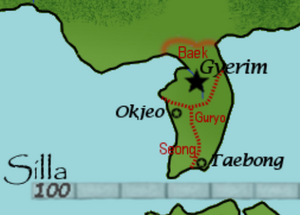Difference between revisions of "Silla"
(information pulled from old wiki. infobox information commented out.) |
(+country infobox) |
||
| Line 1: | Line 1: | ||
{{stub}} | {{Country Infobox | ||
| | |||
|Silla | |||
|Gyerim | |||
|Bureaucratic Monarchy | |||
|Maripgan Ponseong Yurye | |||
| | |||
| | |||
|Humans, Half-breeds, Dragoons (??) | |||
|different people | |||
|Korea}} | |||
{{stub}} | |||
==Overview== | ==Overview== | ||
==Culture== | ==Culture== | ||
| Line 32: | Line 44: | ||
===Peculiar Destinations=== | ===Peculiar Destinations=== | ||
==See Also== | ==See Also== | ||
Latest revision as of 03:35, 13 September 2022
| Silla | |
|---|---|
| Capital City: | Gyerim |
| System of Governance: | Bureaucratic Monarchy |
| Leader(s) | Maripgan Ponseong Yurye |
| Primary Religion: | |
| Languages | |
| Majority Races | Humans, Half-breeds, Dragoons (??) |
| Strong Minorities | different people |
| Real World Influence: | Korea |
Overview
Culture
Religions
Social Structure
Customs and Holidays
Arts and Exceptionalism
Politics
Government
Silla is a bureaucratic monarchy not profoundly disimilar from subdivisions of Shalkara. The role as arbiter it has played between Shalkara and Nippon has caused Silla to be renowned for clever diplomacy and as a consequence exports a suprising number of dimplomats and negotiators trading on that reputation.
The ruling dynasty since the 1780 liberation of Silla has been the Ponseong line, of which the current king or "Maripgan" is Ponseong Yurye, who has been in power since the 1980 death of his father Maripgan Ponseong Gogureok.
Organization of the Land
Demographics
Silla has a higher population percentage of (acknowledged) Dragoons than any other nation in the world and is thought by many to be the true homeland of the race. Dragoons represent a plurality of the upper class and are found throughout Sillan society. The forthrightness of Dragoons in Sillan culture has allowed both Shalkara and Nippon, who have exceptional historical reverence for the Great Dragons, to romanticize their otherwise baldly political position with regards to the small but assertive nation that separates them.
Economy
Foreign Relations
History
Early History
National History
Founded sometime in the third or fourth century, the kingdom of Silla was an aggregation of smaller more tribal societies in the southern portions of Shalkara and eventually grew to be a substantial empire including a great deal of land in what is now Shalkara.
As the power and influence of Shalkara grew, Silla was driven back and ultimately conquered by Shalkara, and later by Nippon. It did not regain independence as a state in its own right until the eighteenth century, during a period of negotiations to diminish hostilities between Shalkara and Nippon by supporting Silla as a buffer state between them.
Since that time, it has functioned as a place of almost sacred international negotiation between the two empires, its independence and impartiality being guaranteed by a sense of national indignation at the role it has played as pawn in the past.
